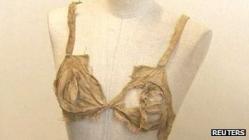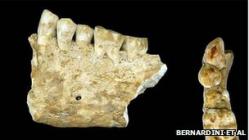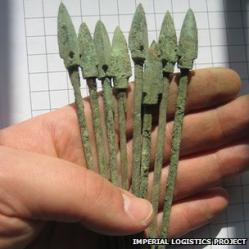PART.2
July

Lingerie from the Middle Ages was among almost 3,000 beautifully preserved fabric items that were found during reconstruction works at Lengberg Castle in Austria.
Among the extremely rare fabric pieces were a 15th-Century bra and knickers similar to those worn today, providing a glimpse into the very private matter of underwear in medieval Europe.
August

Two years after the disruption caused by Icelandic volcano Eyjafjallajökull came news of a somewhat more powerful and deadly volcano that erupted around 750 years ago. Ejecting eight times the volume of debris than the 1883 eruption of Krakatoa, this was the largest known eruption of the last millennium. The location of the volcano itself is still a matter of debate, but the effect it had around the globe remains visible in ice cores, lake sediments, and now mass graves excavated in London.
Historical documents record the devastation reaped by the eruption in AD1258 as the plume of aerosols ejected from the volcano shielded the earth from sunlight and warmth. Thousands of miles away in St Albans, a monk penned his observations of the deteriorating weather, unaware of its volcanic cause. Crops failed and thousands starved; as epidemiologist William Farr put it in 1846, "in London alone 15,000 of the poor perished".
During excavations at Spitalfields cemetery by Museum of London Archaeology (pictured), several burial pits were discovered. Although these graves bore similarities to the "plague pits" of the 14th Century, radiocarbon dating placed them in the mid-13th Century, thus potentially providing the first archaeological evidence for the 1258 volcano.
September

One of the earliest examples of prehistoric dentistry came to light this month with the chance discovery of a beeswax filling in a cracked Neolithic tooth. The tooth belonged to a 24- to 30-year-old man who lived approximately 6,500 years ago in what is now Slovenia.
High-resolution 3D imaging of the tooth revealed an area of exposed dentine as well as a vertical crack extending down to the pulp chamber. The beeswax seal may well have been an attempt to soothe his inevitable toothache.
October

New research by University College London and the Museum of Emperor Qin Shi Huang's Mausoleum shed light on the sophisticated production model used to create the 7,000 warriors, chariots and horses of the Terracotta Army just over 2,000 years ago - following the exciting find in June of 100 more warriors.
Co-ordinating a workforce of over 700,000 men to create finely crafted items to a high level of standardisation was a massive organisational feat that demanded the most innovative of production systems. Analysis of the bronze arrowheads carried by the warriors led researchers to suggest that the Army was built using a production process now referred to as "Toyotism", named after the Japanese car firm.
Unlike an assembly-line model, where specialised production units make individual components, this process utilises cellular workshops with highly skilled and versatile craftspeople that make complete end products: a flexible production system that maximises labour and minimises waste.
November
 Heading into winter saw a burst of new evidence to overturn the view that people in Mesolithic Britain were constantly on the move, living in temporary shelters that left little trace in the landscape.
Heading into winter saw a burst of new evidence to overturn the view that people in Mesolithic Britain were constantly on the move, living in temporary shelters that left little trace in the landscape.
Mesolithic structures were excavated at Echline in Scotland and Lunt Meadows in Merseyside, dating to 8300BC and 5800BC, respectively. The Scottish "house" was a timber and turf structure, occupied seasonally during the winter months. In Merseyside, three structures were found, leading archaeologists to suggest that several families lived in the area for at least part of the year.
New research at Star Carr, one of Britain's most famous Mesolithic sites (pictured), corroborates these findings. Around 11,000 years ago, Star Carr extended over 2 hectares, with a 30m-long wooden lakeside platform and at least one post-built house - not the signature of a small hunter-gatherer camp.
December

December saw the discovery of a very rare cremation burial in an equally rare Iron-Age helmet. The bronze helmet, dating to the 1st Century BC, once contained a bag of cremated bone held together with a brooch - the first example of a bag burial in a helmet. Continuing analysis of the helmet, brooch and bone will hopefully shed light on how this helmet - originally from outside Britain - made its way to a field near Canterbury at a time of war and Roman invasion.
Yet to come...

Early in 2013 we can expect to finally hear the DNA results on the human remains found in a car park in Leicester.
The results will be released at a press conference in January, though early reports suggest that the remains will be confirmed as those of King Richard III.